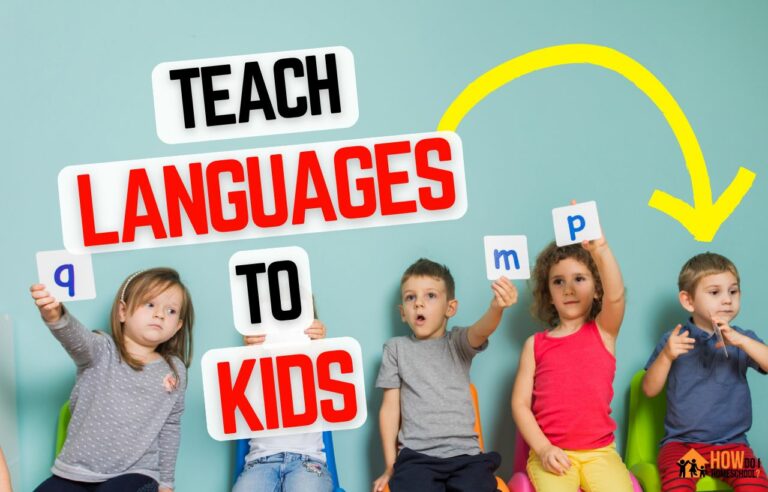Are you considering teaching your little ones a foreign language at home? If so, you’re on the right track! Research has shown that young children have a remarkable ability to learn new languages. Teaching foreign languages at home has many benefits, such as improved cognitive skills, better academic performance, and increased cultural sensitivity.

I hope you enjoy reading this blog post. If you want to do my course on how to homeschool, click here.
In this article, we’ll share some tips and strategies to help you create a language-rich environment in your home and support your child’s language-learning journey. Let’s dive in!

This is a guest post by Valeriia Voloshko
Surround Your Child with the Language
The first step to teaching your child a foreign language is to surround them with the language as much as possible.
This means exposing them to the language in various forms and contexts, such as audio materials, books, videos, and interactions with native speakers.
Parents can create a language-rich environment by:
- playing music,
- watching movies or shows in the target language,
- reading books and stories,
- labeling objects around the house, and
- speaking to the child in the target language as much as possible.
Consistency is critical, and parents should aim to integrate the target language into their daily routines and activities.
Creating a language-rich environment will motivate children to learn and engage with the language, leading to a more immersive and compelling learning experience.
Strategies for creating a language-rich environment
Because surrounding kids with a language-rich environment is key to motivating them to learn the language, here are some more strategies for creating a language-diverse environment:
- Play audio materials in the target language throughout the day, such as music, podcasts, or TV shows.
- Incorporate the language into daily routines and activities, such as counting, naming objects, or giving commands in the target language.
- Find language immersion programs or language exchanges where your child can interact with native speakers of the target language.
- Label everyday objects around the house in the target language.
- Read stories and books in the target language.
- Use flashcards or other visual aids to help your child learn new words and phrases.
By doing this, your child will be exposed to the language in different forms and contexts, which will help them to become more motivated and engaged with the language.
Use Language Learning Platforms to Supplement Learning
In addition to the above strategies, parents can utilize language learning platforms to supplement their child’s learning.
One such platform is the Promova Language Learning Platform.
Promova is an interactive and engaging language learning platform that offers personalized lessons based on the child’s proficiency level.
Promova offers numerous features and benefits, including access to native speakers for conversation practice, fun and interactive lessons that include games and quizzes, and personalized feedback to help children improve their language skills.
Benefits of Language Immersion for Young Children
Immersion in the target language has numerous benefits for young children, including improved pronunciation and fluency, increased cultural understanding and sensitivity, and enhanced cognitive development.
Language immersion is an effective way to teach young children a foreign language as it surrounds them with the language naturally and interactively. This language learning method has been shown to improve pronunciation and fluency and increase cultural understanding and sensitivity.
By immersing your child in the language, they are exposed to authentic materials such as music, videos, and books, which help them to understand the language in context.
Additionally, being regularly exposed to the language can help young children develop a sense of comfort and familiarity with the language, leading to increased motivation and confidence in speaking it.
Language immersion is a powerful way to help young children learn a foreign language and develop a lifelong appreciation for other cultures.
Incorporate Play-Based Learning Activities
Incorporating play-based learning activities is a fun and engaging way to teach young children a foreign language.
Using games, songs, role-playing, and storytelling, children can learn new vocabulary and grammar rules enjoyably.
In addition, play-based learning as well as teaching English online helps children to retain information better as it stimulates their imagination, creativity, and curiosity even at home, while having an online lesson.
Furthermore, it allows children to practice their language skills in a safe and supportive environment, boosting their confidence and motivation to continue learning.
By making language learning enjoyable and interactive, children are more likely to develop a positive attitude toward the language and feel more motivated to continue learning it in the long term.
Make Learning Fun and Engaging
Young children learn best through play and hands-on activities. Here are some examples of play-based learning activities that can be used to teach a foreign language:
- Use games and puzzles to teach vocabulary and grammar in a fun and interactive way.
- Sing songs and nursery rhymes in the target language to help children develop their pronunciation and intonation.
- Encourage role-playing and storytelling in the target language to develop children’s speaking and listening skills.
- Simon Says: This classic game can be adapted to teach kids vocabulary and actions in a foreign language. For example, “Simon says levanta los brazos” (Simon says raise your arms) in Spanish.
- Puppet Shows: Kids can practice their language skills by creating their own puppet shows and performing them in the target language. They can make puppets out of paper bags, socks, or any other materials they have on hand.
- Treasure Hunt: Hide objects around the house and give kids clues in the foreign language to find them. For example, “El libro rojo está debajo de la mesa” (The red book is under the table) in Spanish.
- Board Games: Play board games such as Snakes and Ladders or Memory, but with cards or boards in the target language. Kids can practice counting, colors, or other vocabulary related to the game.
- Cooking: Cook a recipe from a country where the target language is spoken, and have kids help with measuring, mixing, and following instructions in the foreign language. They can also learn new vocabulary related to cooking and food.
Play-based learning activities increase children’s motivation and engagement in learning, improve their memory retention and language acquisition, and enhance their creativity and problem-solving skills.
Tailor Your Approach to Your Child’s Learning Style
Understand Your Child’s Learning Style
Every child has a unique learning style, and it’s essential to tailor your approach to your child’s individual needs. Here are some types of learning styles to consider:
- Visual learners learn best through visual aids and pictures.
- Auditory learners learn best through music and sound effects.
- Kinesthetic learners learn best through hands-on activities and movement.
There are also homeschooling methods you should look into. If you don’t know much about homeschooling methods, take a look at the video to learn them in a fun way!
Strategies for Teaching to Different Learning Styles
When teaching a foreign language to young children, it’s important to consider their learning styles to make the learning experience more effective and enjoyable.
There are three main learning styles: visual, auditory, and kinesthetic. Visual learners learn best through seeing images, charts, and diagrams.
Use flashcards, picture books, and videos with subtitles to teach this style. Auditory learners learn best through hearing and speaking, so include listening and speaking activities, such as songs, rhymes, and conversation practice.
Kinesthetic learners learn best through physical movement and touch, so incorporate hands-on activities such as role-playing, charades, and physical games to help them understand the language.
It’s also helpful to mix and match different strategies and materials to cater to all learning styles, making language learning a more comprehensive and well-rounded experience for young children.
 Conclusion
Conclusion
Teaching young children a foreign language at home can be a rewarding experience for both parents and children. By creating a language-rich environment, incorporating play-based learning activities, tailoring the approach to their child’s learning style, and utilizing language learning platforms, parents can help their children develop their language skills and increase their cultural understanding and sensitivity. It’s important to remember that learning a foreign language takes time, patience, and dedication, but the lifelong benefits are invaluable.
By teaching children a foreign language at a young age, parents give them a gift that will benefit them throughout their lives. So, if you’re a parent considering teaching your child a foreign language, don’t hesitate to start today and enjoy the journey together!


 Conclusion
Conclusion

